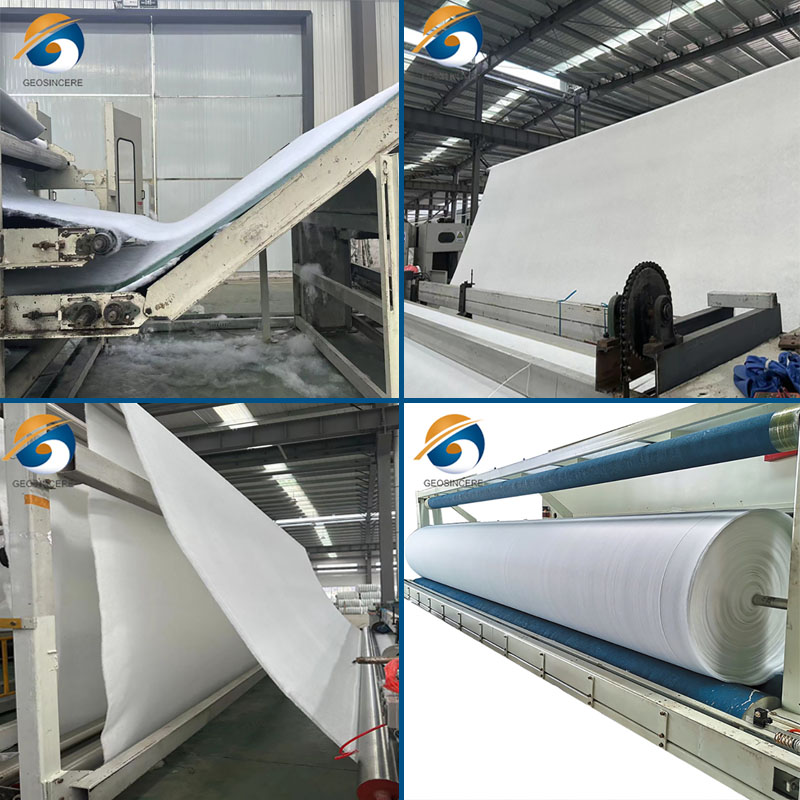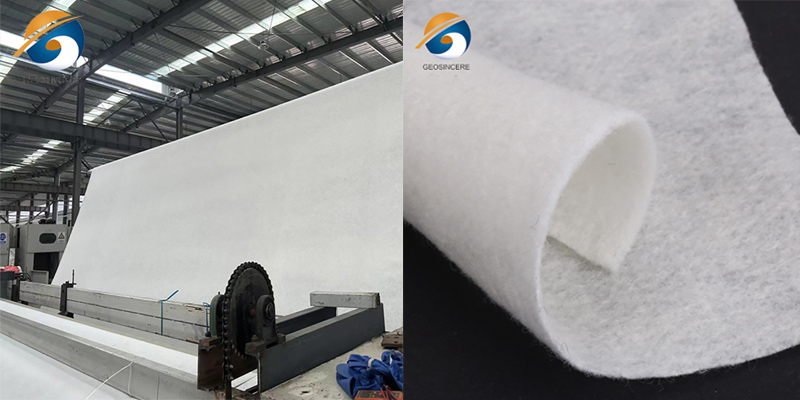Nonwoven Polyester Permeable Geotextile Separation Fabric
Nonwoven polyester permeable geotextile separation fabric is a type of geosynthetic material used in various civil engineering and construction applications. It is designed to provide separation, filtration, and reinforcement functions in soil and aggregate-based structures.Nonwoven polyester permeable geotextile separation fabric is typically made from 100% polyester fibers that are mechanically bonded together, forming a stable and durable material. The fabric is engineered to have a porous structure, allowing the passage of water while retaining soil particles.
The primary function of this geotextile is to create a separation layer between different soil or aggregate materials. It prevents the mixing of fine particles with coarser materials, such as the intermixing of subsoil with granular fill. By preventing the mixing, it maintains the integrity and stability of the different layers, enhancing the overall performance of the structure.
When it comes to road construction, soil stabilization, erosion control, and drainage solutions, Nonwoven Polyester Permeable Geotextile Separation Fabric stands out as one of the most effective and versatile geosynthetic materials available in the modern civil engineering world. This fabric is a crucial element in sustainable infrastructure development, providing long-term performance, superior filtration, and excellent separation properties.
In this article, we explore why Nonwoven Polyester Permeable Geotextile Separation Fabric is the top choice for contractors, engineers, and environmental specialists worldwide.
🧵 What is Nonwoven Polyester Permeable Geotextile Separation Fabric?
Nonwoven Polyester Permeable Geotextile Separation Fabric is a needle-punched, thermally bonded fabric made from 100% high-tenacity polyester fibers. Unlike woven geotextiles, nonwoven types have a random fiber structure, which creates superior permeability and durability, making them ideal for a wide range of geotechnical applications.
This fabric is widely used in soil separation, subgrade reinforcement, drainage enhancement, and filtration systems.
✅ Key Advantages of Nonwoven Polyester Permeable Geotextile Separation Fabric
🌧️ Excellent water permeability to facilitate subsurface drainage
🧱 Outstanding soil separation to prevent mixing of base and subgrade layers
🚧 Superior puncture and tensile strength to withstand heavy construction loads
♻️ Eco-friendly and durable polyester composition
🛠️ Easy to install and cut on-site
🦠 Resistant to biological and chemical degradation
📆 Long service life in harsh environments
Thanks to its unique structure, Nonwoven Polyester Permeable Geotextile Separation Fabric performs reliably under diverse environmental conditions, ensuring long-term cost savings and structural integrity.
🔧 Technical Specifications
| Feature | Specification |
|---|---|
| Material | 100% Polyester (PET) |
| Fabric Type | Needle-punched Nonwoven |
| Weight Range | 100 – 800 gsm |
| Thickness | 0.8 – 6.5 mm |
| Permeability | > 100 L/m²/s |
| Color | White, Grey, or Custom |
| UV Resistance | High |
| Roll Width | 1m to 6m |
| Roll Length | 50m to 100m |
All Nonwoven Polyester Permeable Geotextile Separation Fabric options can be customized based on project needs.
🏗️ Applications of Nonwoven Polyester Permeable Geotextile Separation Fabric
Road Construction: Prevents aggregate contamination and strengthens roadbeds.
Railway Engineering: Stabilizes ballast and maintains subgrade integrity.
Landfills and Dams: Acts as a filtration and protective cushion layer.
Drainage Systems: Enhances flow while preventing soil intrusion.
Slope Protection: Controls erosion by holding soil in place.
Underground Utilities: Protects pipelines and cables from soil migration.
Landscape Engineering: Used in gardens, golf courses, and retaining walls.
The versatility of Nonwoven Polyester Permeable Geotextile Separation Fabric makes it indispensable across both public infrastructure and private development projects.
🔬 How It Works: Separation, Filtration & Stabilization
The effectiveness of Nonwoven Polyester Permeable Geotextile Separation Fabric lies in its three primary functions:
1. Separation
It forms a barrier between different soil layers, preventing them from mixing. This preserves structural integrity and load distribution in roads and embankments.
2. Filtration
Its porous structure allows water to pass through while retaining soil particles, making it perfect for drainage trenches, retaining walls, and underdrains.
3. Stabilization
By distributing loads over a broader area and enhancing friction between layers, it reinforces weak subgrades and reduces settlement.
Nonwoven Polyester Permeable Geotextile Separation Fabric performs these functions simultaneously, offering unmatched geotechnical performance.
🚧 Why Polyester Over Polypropylene?
While both polyester (PET) and polypropylene (PP) are used in geotextiles, Nonwoven Polyester Permeable Geotextile Separation Fabric offers several advantages:
Higher long-term tensile strength
Better resistance to UV and heat aging
Lower creep under sustained loading
Superior chemical resistance in acidic environments
This makes polyester-based fabrics more suitable for heavy-duty, long-term infrastructure.
📦 Packaging & Delivery
Nonwoven Polyester Permeable Geotextile Separation Fabric is typically rolled and wrapped with plastic film for moisture protection. Rolls are labeled with product specs and can be palletized or loaded directly into containers for export.
Fast delivery within 7–15 working days
OEM/ODM support
Global shipping available
🌱 Sustainability & Environmental Impact
Nonwoven Polyester Permeable Geotextile Separation Fabric plays a vital role in eco-friendly construction by:
Reducing the need for thick aggregate layers
Minimizing land disturbance and erosion
Enhancing groundwater recharge through efficient drainage
Being fully recyclable and non-toxic
It aligns with modern green infrastructure principles and supports LEED and Envision certification goals.
🧩 Frequently Asked Questions (FAQ)
Q1: Can Nonwoven Polyester Permeable Geotextile Separation Fabric be used in marine environments?
Yes, polyester fabric is highly resistant to saltwater and is used in coastal and shoreline protection.
Q2: How does it compare with woven geotextiles?
Nonwoven geotextiles offer better water permeability and are ideal for filtration and separation, while woven types provide higher tensile strength for reinforcement.
Q3: Is it suitable for cold climates?
Absolutely. Polyester maintains flexibility and strength even in freezing temperatures.
Q4: How long does the fabric last underground?
Over 50 years when protected from UV and used in stable soil conditions.
🛒 Where to Buy Nonwoven Polyester Permeable Geotextile Separation Fabric?
When sourcing Nonwoven Polyester Permeable Geotextile Separation Fabric, choose a manufacturer that offers:
Certified ISO 9001 production
Full QC and third-party testing reports
Competitive factory pricing
Custom sizes and weights
Technical consultation and layout design
Investing in quality Nonwoven Polyester Permeable Geotextile Separation Fabric ensures higher performance and longer service life for all your civil engineering needs.
🚀 Conclusion: The Smart Choice for Every Infrastructure Project
Whether you're constructing a highway, laying utility lines, or reinforcing a slope, Nonwoven Polyester Permeable Geotextile Separation Fabric is your go-to geotechnical solution. With outstanding filtration, separation, and stabilization capabilities, this fabric is engineered to meet the most demanding environmental and structural requirements.
Future-proof your project with the reliability and efficiency of Nonwoven Polyester Permeable Geotextile Separation Fabric — the foundation of smarter, stronger, and greener infrastructure.
Parameter
Item | Test Method | Unit | 10 | 15 | 20 | 25 | 30 | 35 | 40 | 45 | 50 | 60 |
Index Properties | ||||||||||||
Ultimate Tensile Strength. MD | ASTM D4595 | KN/m | 1 | 11 | 14 | 17 | 19 | 24 | 27 | 30 | 37 | 41 |
Ultimate Tensile Strength, TD | ASTM D4595 | KN/m | 6 | 10 | 12 | 15 | 17 | 21 | 25 | 28 | 34 | 38 |
Tensile Elongation | ASTM D4595 | % | 45 | 45 | 50 | 50 | 50 | 60 | 60 | 60 | 60 | 60 |
Grab Tensile Strength. MD | ASTM D4632 | N | 400 | 600 | 850 | 1000 | 1250 | 1450 | 1700 | 1900 | 2100 | 2500 |
Grab Tensile Strength, TD | ASTM D4632 | N | 350 | 550 | 700 | 900 | 1100 | 1250 | 1450 | 1600 | 1800 | 2150 |
Grab Elongation | ASTM D4632 | % | 45 | 45 | 50 | 50 | 50 | 60 | 60 | 60 | 60 | 60 |
Trapezoid Tear Strength. MD | ASTM D4533 | N | 160 | 300 | 350 | 430 | 490 | 540 | 630 | 710 | 770 | 920 |
Trapezoid Tear Strength, TD | ASTM D4533 | N | 140 | 270 | 330 | 400 | 450 | 510 | 610 | 690 | 750 | 900 |
CBR Puncture Strength | ASTM D6241 | N | 1000 | 1800 | 2300 | 2700 | 3200 | 3600 | 4400 | 4800 | 5800 | 6900 |
Apparent Opening Size 090 | ASTM D4751 | mm | 0.12 | 0.11 | 0.11 | 0.10 | 0.09 | 0.08 | 0.08 | 0.08 | 0.08 | 0.08 |
Water Flow Q100 | ASTM D4491 | L/m2/s | 250 | 235 | 220 | 200 | 185 | 165 | 125 | 110 | 90 | 80 |
Weight | ASTM D5261 | G/m2 | 100 | 150 | 200 | 250 | 300 | 350 | 400 | 450 | 500 | 600 |
Thickness | ASTM D5199 | mm | 1.2 | 1.8 | 2.3 | 2.9 | 3.2 | 3.6 | 3.9 | 4.2 | 4.4 | 4.8 |
Roll width | / | m | 6 | 6 | 6 | 6 | 6 | 6 | 6 | 6 | 6 | 6 |
Roll Length | / | m | 300 | 200 | 150 | 100 | 100 | 100 | 80 | 80 | 50 | 50 |
Nonwoven Polyester Permeable Geotextile Separation Fabric for Sale Features













